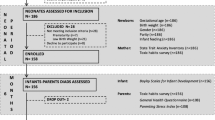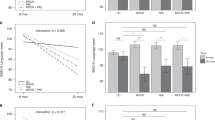Abstract
Purpose
The aim of the study was to examine if there was an association between use of anxiolytics and hypnotics in pregnancy and language competence in the offspring at age 3 years.
Methods
The Norwegian Mother and Child Cohort Study (MoBa) is a prospective pregnancy cohort where the mothers were asked to report on their medication use at pregnancy week 17–18, 30, and at 6 months postpartum. A woman was defined as a user of anxiolytics and hypnotics during pregnancy if she had reported use of benzodiazepines or benzodiazepine-related drugs during pregnancy. Children’s language competence was measured at age three by maternal report on a validated language grammar scale. We used ordinal logistic regression with estimated standard errors allowing for clustering of multiple pregnancies.
Results
Forty-five thousand and two hundred sixty-six women with 51,748 pregnancies were included in the study. The women reported use of anxiolytics and/or hypnotics in 395 pregnancies (0.8 %). The odds ratios of being in a group with lower language competence were 1.2 (0.9–1.5) and 1.7 (1.0–2.8) for short-term and long-term anxiolytics and hypnotics use, respectively. When adjusting for SSRI use during pregnancy, the odds ratios were 1.1 (0.83–1.41) and 1.4 (0.84–2.33), respectively. Children whose mothers took no anxiolytics and hypnotics during or before pregnancy were reference group.
Conclusion
The results refute any strong association between prenatal use of anxiolytics and hypnotics and lower language competence in the offspring at age 3 years.
Similar content being viewed by others
References
Facco FL, Kramer J, Ho KH, Zee PC, Grobman WA (2010) Sleep disturbances in pregnancy. Obstet Gynecol 115(1):77–83. doi:10.1097/AOG.0b013e3181c4f8ec
Hedman C, Pohjasvaara T, Tolonen U, Suhonen-Malm AS, Myllyla VV (2002) Effects of pregnancy on mothers’ sleep. Sleep Med 3(1):37–42
Hutchison BL, Stone PR, McCowan LM, Stewart AW, Thompson JM, Mitchell EA (2012) A postal survey of maternal sleep in late pregnancy. BMC Pregnancy Childbirth 12:144. doi:10.1186/1471-2393-12-144
Pien GW, Schwab RJ (2004) Sleep disorders during pregnancy. Sleep 27(7):1405–1417
Sahota PK, Jain SS, Dhand R (2003) Sleep disorders in pregnancy. Curr Opin Pulm Med 9(6):477–483
Rubertsson C, Hellstrom J, Cross M, Sydsjo G (2014) Anxiety in early pregnancy: prevalence and contributing factors. Arch Womens Ment Health. doi:10.1007/s00737-013-0409-0
Andersson L, Sundstrom-Poromaa I, Bixo M, Wulff M, Bondestam K, aStrom M (2003) Point prevalence of psychiatric disorders during the second trimester of pregnancy: a population-based study. Am J Obstet Gynecol 189(1):148–154
Buhimschi CS, Weiner CP (2009) Medications in pregnancy and lactation: part 1. Teratol Obstet Gynecol 113(1):166–188. doi:10.1097/AOG.0b013e31818d6788
Engeland A, Bramness JG, Daltveit AK, Ronning M, Skurtveit S, Furu K (2008) Prescription drug use among fathers and mothers before and during pregnancy. A population-based cohort study of 106,000 pregnancies in Norway 2004–2006. Br J Clin Pharmacol 65(5):653–660. doi:10.1111/j.1365-2125.2008.03102.x
Gillberg C (1977) “Floppy infant syndrome” and maternal diazepam. Lancet 2(8031):244
McElhatton PR (1994) The effects of benzodiazepine use during pregnancy and lactation. Reprod Toxicol 8(6):461–475
Rementeria JL, Bhatt K (1977) Withdrawal symptoms in neonates from intrauterine exposure to diazepam. J Pediatr 90(1):123–126
Laegreid L, Hagberg G, Lundberg A (1992) Neurodevelopment in late infancy after prenatal exposure to benzodiazepines—a prospective study. Neuropediatrics 23(2):60–67. doi:10.1055/s-2008-1071314
Viggedal G, Hagberg BS, Laegreid L, Aronsson M (1993) Mental development in late infancy after prenatal exposure to benzodiazepines—a prospective study. J Child Psychol Psychiatr Allied Discip 34(3):295–305
Magnus P, Irgens LM, Haug K, Nystad W, Skjaerven R, Stoltenberg C (2006) Cohort profile: the Norwegian Mother and Child Cohort Study (MoBa). Int J Epidemiol 35(5):1146–1150. doi:10.1093/ije/dyl170
Irgens LM (2000) The medical birth registry of Norway. Epidemiological research and surveillance throughout 30 years. Acta Obstet Gynecol Scand 79(6):435–439
ATC Classification Index with DDDs (2013) WHO Collaborating Centre for Drug Statistics Methodology
Skurtveit S, Selmer R, Roth C, Hernandez-Diaz S, Handal M (2014) Prenatal exposure to antidepressants and language competence at age three: results from a large population-based pregnancy cohort in Norway. BJOG: Int J Obstet Gynaecol. doi:10.1111/1471-0528.12821
Skurtveit S, Selmer R, Tverdal A, Furu K, Nystad W, Handal M (2013) Drug exposure: inclusion of dispensed drugs before pregnancy may lead to underestimation of risk associations. J Clin Epidemiol 66(9):964–972. doi:10.1016/j.jclinepi.2013.02.011
Skurtveit S, Selmer R, Odsbu I, Handal M (2014) Self-reported data on medicine use in the Norwegian Mother and Child cohort study compared to data from the Norwegian Prescription Database
Dale PS, Price TS, Bishop DV, Plomin R (2003) Outcomes of early language delay: I. Predicting persistent and transient language difficulties at 3 and 4 years. J Speech Lang Hear Res 46(3):544–560
Roth C, Bjorke-Monsen AL, Reichborn-Kjennerud T, Nilsen RM, Smith GD, Stoltenberg C, Suren P, Susser E, Ueland PM, Vollset SE, Magnus P (2013) Use of folic acid supplements in early pregnancy in relation to maternal plasma levels in week 18 of pregnancy. Mol Nutr Food Res 57(4):653–660. doi:10.1002/mnfr.201200116
Wikner BN, Stiller CO, Kallen B, Asker C (2007) Use of benzodiazepines and benzodiazepine receptor agonists during pregnancy: maternal characteristics. Pharmacoepidemiol Drug Saf 16(9):988–994. doi:10.1002/pds.1391
Roth C, Magnus P, Schjolberg S, Stoltenberg C, Suren P, McKeague IW, Davey SG, Reichborn-Kjennerud T, Susser E (2011) Folic acid supplements in pregnancy and severe language delay in children. JAMA 306(14):1566–1573. doi:10.1001/jama.2011.1433
Greenland S (1996) Basic methods for sensitivity analysis of biases. Int J Epidemiol 25(6):1107–1116
Riska BS, Skurtveit S, Furu K, Engeland A, Handal M (2014) Dispensing of benzodiazepines and benzodiazepine-related drugs to pregnant women: a population-based cohort study. Eur J Clin Pharmacol 70(11):1367–1374. doi:10.1007/s00228-014-1744-4
Nilsen RM, Vollset SE, Gjessing HK, Skjaerven R, Melve KK, Schreuder P, Alsaker ER, Haug K, Daltveit AK, Magnus P (2009) Self-selection and bias in a large prospective pregnancy cohort in Norway. Paediatr Perinat Epidemiol 23(6):597–608. doi:10.1111/j.1365-3016.2009.01062.x
Daw JR, Mintzes B, Law MR, Hanley GE, Morgan SG (2012) Prescription drug use in pregnancy: a retrospective, population-based study in British Columbia, Canada (2001–2006). Clin Ther 34(1):239–249.e232. doi:10.1016/j.clinthera.2011.11.025
Andrade SE, Gurwitz JH, Davis RL, Chan KA, Finkelstein JA, Fortman K, McPhillips H, Raebel MA, Roblin D, Smith DH, Yood MU, Morse AN, Platt R (2004) Prescription drug use in pregnancy. Am J Obstet Gynecol 191(2):398–407. doi:10.1016/j.ajog.2004.04.025
Acknowledgments
The Norwegian Mother and Child Cohort Study is supported by the Norwegian Ministry of Health and the Ministry of Education and Research, NIH/NIEHS (contract no. N01-ES-75558), NIH/NINDS (grant no.1 UO1 NS 047537-01, and grant no.2 UO1 NS 047537-06A1). We are grateful to all the participating families in Norway who take part in this ongoing cohort study.
Conflict of interest
The authors declare that they have no conflict of interest.
Author contributions
Authors Odsbu, Skurtveit, Selmer, Roth, and Handal were responsible for the study conception and design, and Skurtveit and Handal did the data acquisition. The analysis and interpretation of data were done by Odsbu, Skurtveit, Selmer, Hernandez-Diaz, and Handal. Drafting of the manuscript was done by Odsbu, Skurtveit, Selmer, and Handal, while Roth and Hernandez-Diaz did the critical revision.
Author information
Authors and Affiliations
Corresponding author
Electronic supplementary material
Below is the link to the electronic supplementary material.
Supplementary Figure 1
Flow chart of study participants (PPTX 73 kb)
ESM 2
(XLSX 19 kb)
Rights and permissions
About this article
Cite this article
Odsbu, I., Skurtveit, S., Selmer, R. et al. Prenatal exposure to anxiolytics and hypnotics and language competence at 3 years of age. Eur J Clin Pharmacol 71, 283–291 (2015). https://doi.org/10.1007/s00228-014-1797-4
Received:
Accepted:
Published:
Issue Date:
DOI: https://doi.org/10.1007/s00228-014-1797-4




